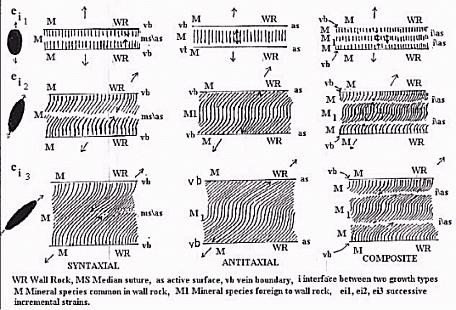SYNTECTONIC CRYSTAL GROWTH

Normally a structural geologist observes only the final strained state of a rock. There is no clue as to how the finite strain that is observed is built up and through what increments of strain, in magnitude, orientation and sign were added at various stages during the build up. In other words, a structural geologist may not be able to construct the precise deformation path taken by an object to arrive at the final deformed state. We have seen that it may be possible to compute incremental shear strain from sigmoidal extension veins and possible. So is it possible to do the same from other syntectonic structures such as the syntectonic crystal growth. The growth can be particularly well marked under low grade metamorphism and the principal mechanism is pressure solution which works on Le Chatlier's principle and Poynting Principle. The material undergoes solution in the direction of the maximum principal compressive stress, and is deposited parallel to the cleavage or l1l2 plane. This was also observed by Cloos during his study of the deformed oolites of South Mountain Anticline, that the oolites were disrupted by extensional fissures and development of fibrous growth of calcite in those cracks.
The sequence is synoptically shown in the schematic diagram below. At the first increment of deformation, a crack, a few microns in width may be developed. Depending upon the geometry of fibres, mineral species and other features, the crystal growth may be described as SYNTAXIAL, ANTITAXIAL OR COMPOSITE and each of these is briefly described below. Please see the figure as you read the description.
Syntaxial Growth: As soon as the crack is generated perpendicular to the maximum principal incremental extension, the commonest of mineral species in the host rock which can undergo solution or pressure solution at those P and T conditions that prevail at the time of the deformation is dissolved and migrates to the space which is being gradually created in the crack by its dilation (literal meaning) and gets deposited in the form of fibres of that mineral species. Quartz, calcite and even chlorite or clinozoisite are found to have acicular habit, quite unlike their natural crystal habit (i.e. the habit or form they take while crystallizing under natural free growth). The crystal fibres always grow in the direction of maximum principal incremental extension. For the growth of crystals, new material is added at the tips of crystals by grain boundary diffusion. The growth of fibres is from the walls towards the centre and hence the term SYNTAXIAL. As the incremental extension direction is changed, the crystal fibres start growing in that direction as this is the direction of easiest. The fibres from two sides grow inwards and meet at the vein centre called MEDIAN SUTURE (ms) which is the ACTIVE SURFACE (as) to which the material is being added. Thus through continued progressive direction in ei1, a sigmoidal symmetrical geometry results. The mineral species of fibres in veins is a common constituent of the rock and even though sigmoidal, the crystals are in complete optical continuity and what is more are in optical continuity with the crystals in the wall rock (WR) near the vein boundary(vb). The pull apart sense of the vein can be known from the geometry of fibres. The crystals are not deformed, they are born with a curved form.
Antitaxial Growtth: When the fracturing occurs, the constituent minerals of the rock are unable to undergo pressure solution under the given P T conditions, but the gap created has to be filled; hence the mineral species which can undergo pressure solution under given P T conditions in surrounding rocks does get dissolved and goes into solution and this then migrates into the crack that is created but in this case, the crystal fibres grow from the centre of the vein towards the vein boundary. In other words, the crystal material is foreign to the rock and vein boundary is the active surface to which the material is being continuously added. The growth is called ANTITAXIAL, i.e. away from the vein axis. The crystals are NOT IN OPTICAL CONTINUITY WITH THOSE IN THE WALL ROCK SINCE THEY ARE FOREIGN TO THE ROCK. Thus while in syntaxial growth, the early chords of crystals lie close to wall rock or vein boundary, in antitaxial, the early stage chords lie near the vein centre. There is no median suture in case of such growth. The sigmoidal geometry results as in case of syntaxial veins through changing incremental strains orientations.
Composite Growth: This is a combination of both syntaxial and antitaxial growth. The crack which is being produced actually dilates at a rate faster than the rate at which the material available can fill it. Owing to this, there occurs growth from the walls of a mineral species commonly found in the rock and also of a mineral species that is foreign to the rock from the centre. The two mineral species are different and the interface between the two types and crystal species is the active surface to which the material is being added through grain boundary diffusion. Thus this growth combines both types and is called composite. The early stage chords of crystals lie near the vein boundary as well as near the vein centre but are of different mineral species.